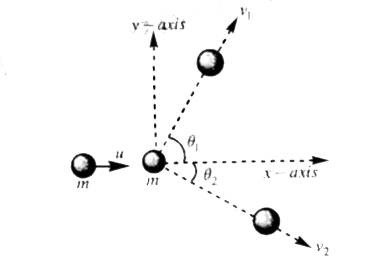Prove that in case of oblique elastic collision of two particles of equal mass if one is at rest, the recoiling particles always move off at right angles to each other

In elastic collision momentum is conserved. So, conservation of momentum along x-axis yields.
mu=mv1cosθ1+mv2cosθ2
i.e., u=v1cosθ1+v2cosθ2….(1)
and along y-axis yields
0=v1sinθ1−v2sinθ2 ....(2)
Squaring and adding Eqns (1) and (2), we get
u2=v21+v22+2v1v2cos(θ1+θ2)....(3)
As the collisions is elastic 12mu2=12mv21+12mv22 i.e., u2−v21+v22....(4) Put u2=v21+v22 in Eqn (3).
we get 2v1v2cos(θ1+θ2)=0
As it is given that v1≠0andv2≠0
so cos(θ1+θ2)=0,i.e.,(θ1+θ2)=90∘
Similar Questions
Prove that as a result of an elastic collision of two nonrelativistic particles of equal mass the scattering angle will be 90°.
View SolutionA particle of mass m experienced an elastic collision with a stationary particle of mass 2m . What fraction of the kinetic energy does the striking particle lose if recoils at the right angles to its original motion direction.
View Solution
Knowledge Check
A ball of mass m moving with a velocity v undergoes an oblique elastic collision with another ball of the same mass m but at rest. After the collision if the two balls move with the same speeds , the angle between their directions of motion will be:
A30∘B60∘C120∘D90∘A particle of mass m moving with velocity →V makes a head on elastic collision with another particle of same mass initially at rest. The velocity of the first particle after the collision will be
A→VB−→VC−2→VDZeroA particle of mass m moving with velocity →V makes a head on elastic collision with another particle of same mass initially at rest. The velocity of the first particle after the collision will be
A→VB−→VC−2→VDzero
A ball of mass m makes an elastic collision with another identical ball at rest. Show that if the collision is oblique, the bodies go at right angles to each other after collision.
View SolutionA particle of mass m1 experienced a perfectly elastic collision with a stationary particle of mass m2. What fraction of the kinetic energy does the striking particle lose, if
(a) it recoils at right angles to its original motion direction,
(b) the collision is a head-on one?
View SolutionIn a perfectly elastic collision in two dimensions between two particles of ………………….mass,the two particles move at …………………..to each other.
View SolutionProve that in a two dimensional elastic collision of a moving ball with another stationary identical ball, the two balls move perpendicular to each other after collision?
View SolutionA particle A suffers an oblique elastic collision particle B that is at rest initially. If their masses with a are the same, then after the collision
View Solution
